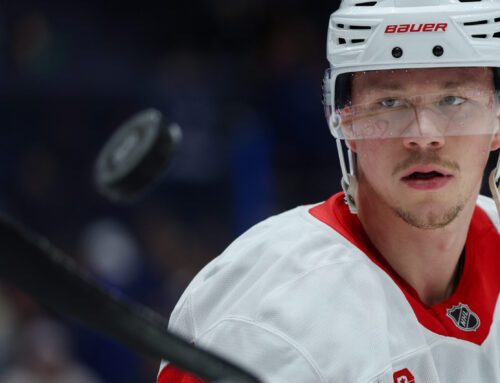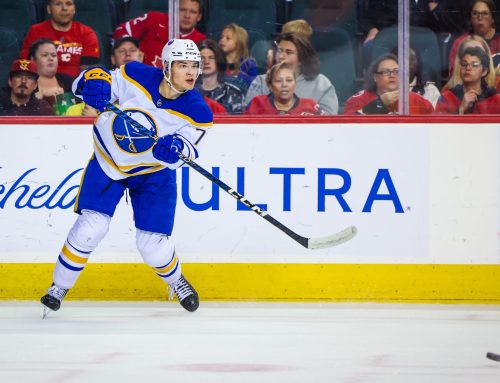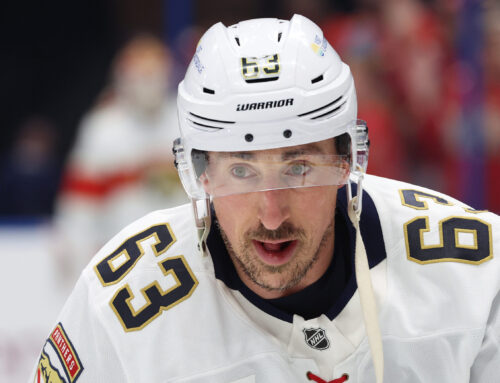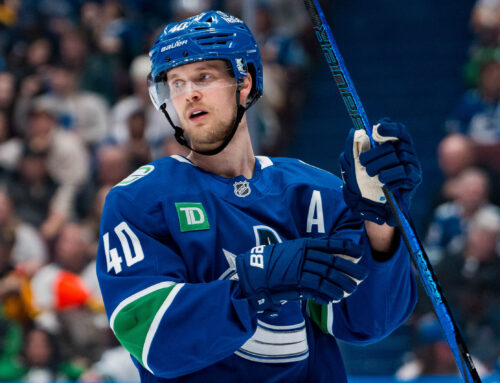
The Midseason Guide is now available for download NOW! Inside you’ll find second-half projections, sleepers, advanced stats, historical trends, prospects you need to know, and more. Purchase yours today if you haven’t already! If you already have, then dive right in and just look up hockey stats and information for hours and hours. My wife and kids and pets love it when I do that.
I wrote the goaltending projections and paragraphs for each team, which take more time than you think. As I’ve said in the past, goalies are to fantasy hockey as running backs are to fantasy football as closers are to fantasy baseball: It’s important to stay on top of who that No.1 guy is for each team. Goalie management is something that I’ve made a priority during most of my fantasy hockey writing career. So I’ll share some information on goaltending trends that could be relevant as you gear up for the second half of the season.
If you have an Athletic subscription, I encourage you to check out Pierre LeBrun’s piece on putting No. 1 goalies on a pitch count. Major league baseball teams now closely monitor their young star pitchers’ pitch counts, and I’ve wondered in the past if NHL teams will do the same.
This trend of managing games played may already be taking place. Since the season-long lockout of 2004-05, goalies have appeared in 70+ games 34 times, but only four times over the last five seasons. The article mentions that Marc-Andre Fleury leads all goalies with 39 games played (all starts), which would put him on pace for 70 this season. With Vegas likely making the playoffs again, wouldn’t it be wise to rest Fleury more during the second half? Malcolm Subban has played in just eight games this season.
The driving force for goalies managing starts is the team’s starter being fresh for a long playoff run. The last starting goalie to win a Stanley Cup and play over 60 games in the regular season was in fact Fleury, when he led the Penguins to a Stanley Cup in 2008-09 – a full decade ago. So it’s worth it for teams with Stanley Cup aspirations to manage their starter’s minutes.
Just as we’ve adjusted (lowered) our GAA and SV% expectations for the increase in scoring, we might need to do the same for games played among goalies. In other words, 60 is the new 70. But it could even get to the point where 55 is the new 60. If goaltending starts are spread out more evenly among the starter and backup, then that could decrease the draft-day value of goalies relative to skaters. In other words, no more drafting Martin Brodeur in the first round because he’s a virtual lock for 70 games and 40 wins.
Another interesting idea was about teams rostering a No. 3 goalie. From the article:
One member of an NHL coaching staff wondered this as far as thinking outside the box: when playing in back-to-back nights, why not fly tomorrow’s starter to the next city ahead of time like pitchers in a playoff series do sometimes? Why is he sitting on the bench the night before and flying in a 2 a.m. with the rest of his team and not sleeping properly?
One reason is because managing a third goalie is about the hardest thing to do in today’s NHL. The CBA rules pretty much make it that most third goalies in the NHL require waivers for normal call-ups. Which is something to look at for the next CBA because the role of the No. 3 goalie may have to expand in a number of ways if teams are going to continue to find ways to better manage their starter.
Such as the idea that the third goalie should be up with the big team helping in practice to give the starter the odd day off.
The third goalie would likely have little to no impact fantasy-wise aside from occasionally entering a game in relief. You may also be less likely to see a goalie dressed as a backup if he is day-to-day with a minor nagging injury or fighting the flu.
*
The late Ducks/Penguins game had numerous momentum swings. The slumping Ducks jumped out to a 3-0 lead in the first period, only to cough it up in the second period. However, Jakob Silfverberg scored a shorthanded goal shortly after the Penguins’ game-tying goal to give the Ducks a 4-3 lead. After that it was all Penguins, as they scored four third-period goals to cruise to a 7-4 victory. There were numerous scoring stars for the Penguins that are certainly worthy of mention.
With Patric Hornqvist sidelined with yet another concussion, Jake Guentzel was back on the first-unit power play. Guentzel took advantage, scoring a power-play goal while also adding an even-strength goal and an empty-net goal to seal the hat trick. Guentzel, who also fired seven shots on goal in this game, now has 21 goals, which is just one shy of his single-season high. Guentzel’s finest play has typically been in the playoffs, so regular-season keeper owners who have been patient are starting to reap the rewards in Guentzel’s third NHL season.
Evgeni Malkin scored a goal and added three assists, giving him points in five consecutive games. That’s nothing new for Malkin, but his presence has lit a fire under Tanner Pearson. Pearson scored two third-period goals (both assisted by Malkin), which gives Pearson four goals in his last five games and six points in his last eight games. Pearson’s numbers haven’t gone through the roof since being traded out of LA, where he was mired in a deep slump (one point in 17 games). But he has benefitted from the move overall with 12 points in 28 games as a Penguin.
Blueliner Marcus Pettersson was the lesser-known player (at least to fantasy owners) in the trade that sent Daniel Sprong to Anaheim. However, the Penguins have to be very happy with this deal. With an assist on Friday, Pettersson now has points in five consecutive games with a plus-10 over that span. Almost no one will confuse him with the rookie with the same last name in Vancouver, but at least he’s receiving second-unit power-play time in Pittsburgh (good for something?) while providing the Pens with much-needed help on the defense.
Also with the Penguins, Casey DeSmith was given a three-year extension with a cap hit of $1.25 million. In spite of the new contract, it’s Matt Murray’s net again. With the win on Friday, Murray has now reeled off nine consecutive wins. There’s always worry that another injury is around the corner (as is the case with many of the Penguins’ big names), but fantasy owners should have zero hesitation in rolling with Murray right now.
Meanwhile, the fragile Ducks have now lost 10 consecutive games, which has to be putting Randy Carlyle’s job security in doubt. Carlyle is no doubt feeling the effects.
Randy Carlyle snapped when asked if he’s worried about his job security and then abruptly ended the interview. Said “dumb question” and then called the reporter a “jerk.”Seat is getting awfully hot with losing streak now at 10 #nhlducks
— Mike Coppinger (@MikeCoppinger) January 12, 2019
John Gibson deserves better. He has not won a game since December 17 in spite of five quality starts since that date.
*
Jack Eichel returned to the Sabres’ lineup on Friday after missing the past three games with an upper-body injury. Hopefully you didn’t rush to add him back into your lineup, as he was held without a point and was a minus-2.
Eichel’s return created some line juggling for the Sabres. Rookie Tage Thompson was moved up to top line, which bumped Sam Reinhart down to a line with Conor Sheary and Vladimir Sobotka, and Evan Rodrigues moved to a line with the fading Jason Pominville. The Rodrigues-Pominville combo actually fared better than Eichel on Friday, as Rodrigues assisted on Pominville’s first goal (and point) since November 23 – a dry spell of 16 games.
In his first game against his former team, Jeff Skinner scored his 30th goal of the season, scored in just his 44th game. Skinner should eclipse his career high of 37 goals set two seasons ago and should even make a serious run for 50 goals, even though his shooting percentage (21.6%) will likely decline as the season wears on.
Unfortunately for Skinner, his former team had the last laugh in this game, winning 4-3. Sebastian Aho scored his 17th and 18th goals of the season, while Micheal Ferland scored a goal and added two assists. Ferland had a cold November and December (six points in 19 games) after a hot October (11 points in 12 games), but he is starting to heat up again in January (six points in six games). He is back on the Aho-Teuvo Teravainen line, so now would be a great time to add him if someone has dropped him in your league.
*
In his first season in the ‘Peg, Laurent Brossoit has turned out to be one of the league’s top backup goalies. With a 33-save win against the Wings on Friday, Brossoit has now posted wins in nine of ten starts as a Jet. Brossoit’s ratios (2.11 GAA, .939 SV) are considerably better than Connor Hellebuyck’s (2.87 GAA, .908 SV%), but Hellboy shouldn’t be considered to be in any danger of losing his starting job. Only one of Brossoit’s ten starts has been against a team currently occupying a playoff spot, so Paul Maurice’s strategy of giving the cupcake starts to the backup may explain why the ratios are the way they are.
Kyle Connor scored a goal and added two assists with a plus-3, giving him points in four consecutive games. It’s clear that his promotion to the top line (with Mark Scheifele and Blake Wheeler) as a result of Nikolaj Ehlers’ injury was exactly what Connor needed to bust his cold spell. Connor had been held without a point for ten consecutive games before the move to the top line. Connor owners have to hope that this arrangement will stick, even when Ehlers returns to the lineup.
*
With all the scoring stars in Calgary (Johnny Gaudreau, Sean Monahan, Elias Lindholm, and Matthew Tkachuk all reaching 50 points and Mark Giordano likely to hit that milestone), it was actually Michael Frolik who led the charge on Friday. Frolik scored a goal and added two assists in the Flames’ 4-3 win over Florida. After Bill Peters made Frolik a healthy scratch on December 29 (to the unsurprising ire of his agent Allan Walsh), Frolik has eight points (4g-4a) in his last seven games. Frolik has been on the Flames’ second line with Tkachuk and Mikael Backlund (known as the 3M line), which seems to be the best situation for him (aside from Calgary’s top line, which no one else will receive a sniff of, barring injury).
*
On Friday, Rick Nash announced his retirement from the NHL after 15 seasons due to concussion symptoms. Nash was a must-own in all fantasy leagues for a good decade, reaching the 30-goal mark eight times and the 40-goal mark three times. Over Nash’s career from 2002-03 until last season, only Alex Ovechkin, Jarome Iginla, and Patrick Marleau had scored more goals than Nash (437). As well, only Ovechkin has taken more shots than Nash (3,624) over that span.
It’s unfortunate that Nash’s name has been added to the growing list of players whose careers have been cut short due to concussion symptoms. There is a lot more awareness of the long-term health effects of concussions than there were when Nash started his career, but I believe that the NHL still has a long way to go in how headshots are addressed. Hopefully this isn’t something that takes a major toll on Nash’s quality of life.
Here’s my favorite Nash goal. To quote the Blue Jackets’ fan who sent me the link when it happened, this goal is absolutely sick.
*
For more fantasy hockey information, you can follow me on Twitter @Ian_Gooding.





 FLA
FLA EDM
EDM CHI
CHI N.J
N.J BUF
BUF WSH
WSH COL
COL T.B
T.B VGK
VGK
